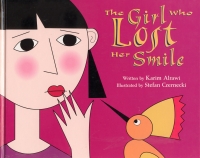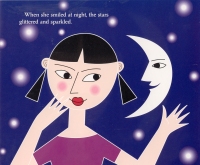| ________________
CM . . .
. Volume XI Number 17 . . . . April 29, 2005
excerpt: In the wondrous city of Baghdad, lived a young girl called Jehan. When Jehan smiled by day, the sun shone brightly. When she smiled at night, the stars glittered and sparkled. One dull morning, Jehan wakes up and finds she has lost her smile. Without her smile, there is no sunshine in Baghdad and the night sky is dark and gloomy. Poor Jehan is certain she will never smile again. Her anxious father asks for help from the small but wise hoopoe bird. The little bird suggests that he invite great artists to come and paint pictures for his daughter. Delighted with this idea, the father invites artists from far and wide, but alas, none of their paintings brings back his daughter's smile. The hoopoe bird travels around the world searching for the right artist. Finally, on his way home, he meets a young Persian man who is sure he can help Jehan. When he arrives at Jehan's home, instead of starting to paint, the Persian takes a scraper from his bag and begins to smooth the wall. The young man asks Jehan to help him in his scraping and polishing. She takes the sandalwood scraper and begins to work. Soon the wall began to glow, and Jehan saw that its beauty had always been there. It had just been waiting for her to uncover it. Jehan began to smile.
Stefan Czernecki's bold and vivid illustrations perfectly complement this simply told tale. Like most folk tales, there is much which is not explained. For example, the reader does not discover how Jehan lost her smile. It may not be immediately clear to young listeners why the young protagonist begins to smile again at the end of the story. However, The Girl Who Lost Her Smile will be appreciated by teachers and librarians looking for a brilliantly illustrated, short, multi-cultural read-aloud with discussion possibilities. As such, it should prove a valuable addition to the elementary school library's collection of Middle Eastern folklore. Recommended. A retired teacher-librarian, Valerie Nielsen lives in Winnipeg, MB.
To comment
on this title or this review, send mail to cm@umanitoba.ca.
Copyright © the Manitoba Library Association. Reproduction for personal
use is permitted only if this copyright notice is maintained. Any
other reproduction is prohibited without permission.
NEXT REVIEW |TABLE OF CONTENTS FOR THIS ISSUE - April 29, 2005. AUTHORS | TITLES | MEDIA REVIEWS | PROFILES | BACK ISSUES | SEARCH | CMARCHIVE | HOME |

 The Girl Who Lost Her Smile is a folktale which was inspired by a story in a collection of
Islamic stories and poetry by 13th century Sufi poet Jallal al-Din Rumi. The author's note tells us
that Jallal as-Din Rumi lived in the Turkish city of Konya where he founded the order of Whirling
Dervishes, an order who use music and dance to achieve a mystical state of worship.
The Girl Who Lost Her Smile is a folktale which was inspired by a story in a collection of
Islamic stories and poetry by 13th century Sufi poet Jallal al-Din Rumi. The author's note tells us
that Jallal as-Din Rumi lived in the Turkish city of Konya where he founded the order of Whirling
Dervishes, an order who use music and dance to achieve a mystical state of worship.